The value of TwitterScore lies in its attempt to quantify the "quality of social capital," which is precisely one of the key dimensions that exchanges use to assess the health, influence, and potential market performance of project communities.
Author: Cube Labs
During the sprint phase for listings, many projects are focused on accumulating Twitter data, increasing followers, and boosting interactions, but can this really translate into opportunities for listings? A surge in followers and superficial interactions are merely the minimum threshold for entry, far from being the decisive factors for exchanges when evaluating projects.
The value of TwitterScore lies in its attempt to quantify the "quality of social capital," which is precisely one of the key dimensions that exchanges use to assess the health, influence, and potential market performance of project communities. By combining recent project case studies, we can see where its data stands in the Web3 social discourse and which dimensions are genuinely of interest to exchanges.
TwitterScore vs. Other Evaluation Platforms:
TwitterScore is an influence scoring tool developed for the Twitter (now X) accounts of crypto projects. Founded by a Russian team, it provides KOLs or projects with an objective and quantifiable social media score by analyzing account content, follower weight, and algorithms, with a scoring range of 0–1000, where the maximum is 1000, helping users measure the reputation and dissemination power of the account within the Web3 community.
The official team has recently begun offering API services and paid packages (from Basic to Enterprise), supporting bulk queries, historical tracking, and categorized follower analysis. In the industry, TwitterScore has been adopted by platforms like Gitcoin to evaluate Web3 projects, reflecting its recognition of digital credibility, and more mainstream exchange listing teams are also using this quantitative metric as an important goal for project evaluations.
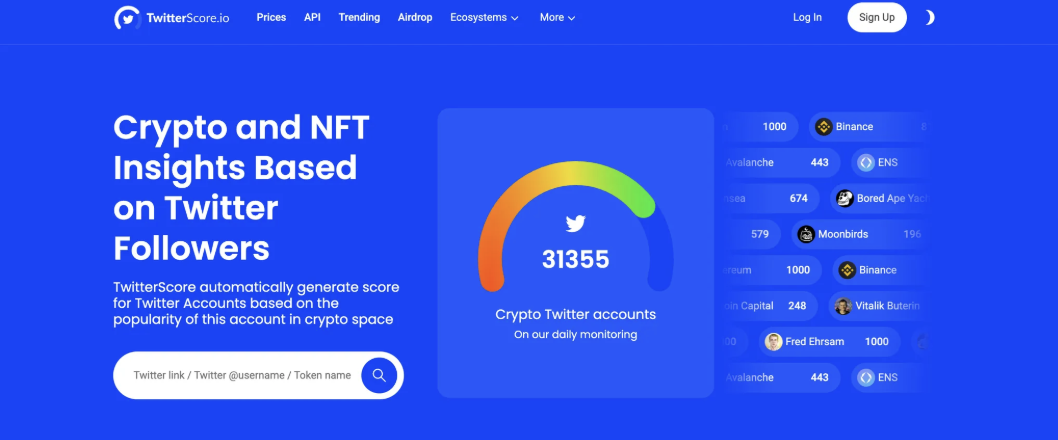
In addition to the general popularity assessment metric of Twitter Score, there are several other platforms in the industry that focus on different dimensions of Web3 social influence evaluation. These platforms provide more refined analytical tools for project teams, investment institutions, and community operators through differentiated data models.
TweetsCount
The scoring system of TweetsCount is quite similar to TwitterScore, but with slight adjustments in algorithm ratios, resulting in higher sensitivity and score variations for projects compared to TwitterScore, making it a useful supplementary data reference. It also has the capability to review bot followers and VC feeds, allowing for quick identification of potential scams during early project research.
By comparing the score growth of a specific project on TwitterScore and TweetsCount over the same period, it is evident that the growth of TweetsCount is closely related to the increase in follower count and high-quality followers; meanwhile, the correlation of TwitterScore with natural follower growth is relatively low, with actual verification showing a higher correlation with high-quality follower weight. However, both can reflect changes in the quality of Twitter social media during a specific period.
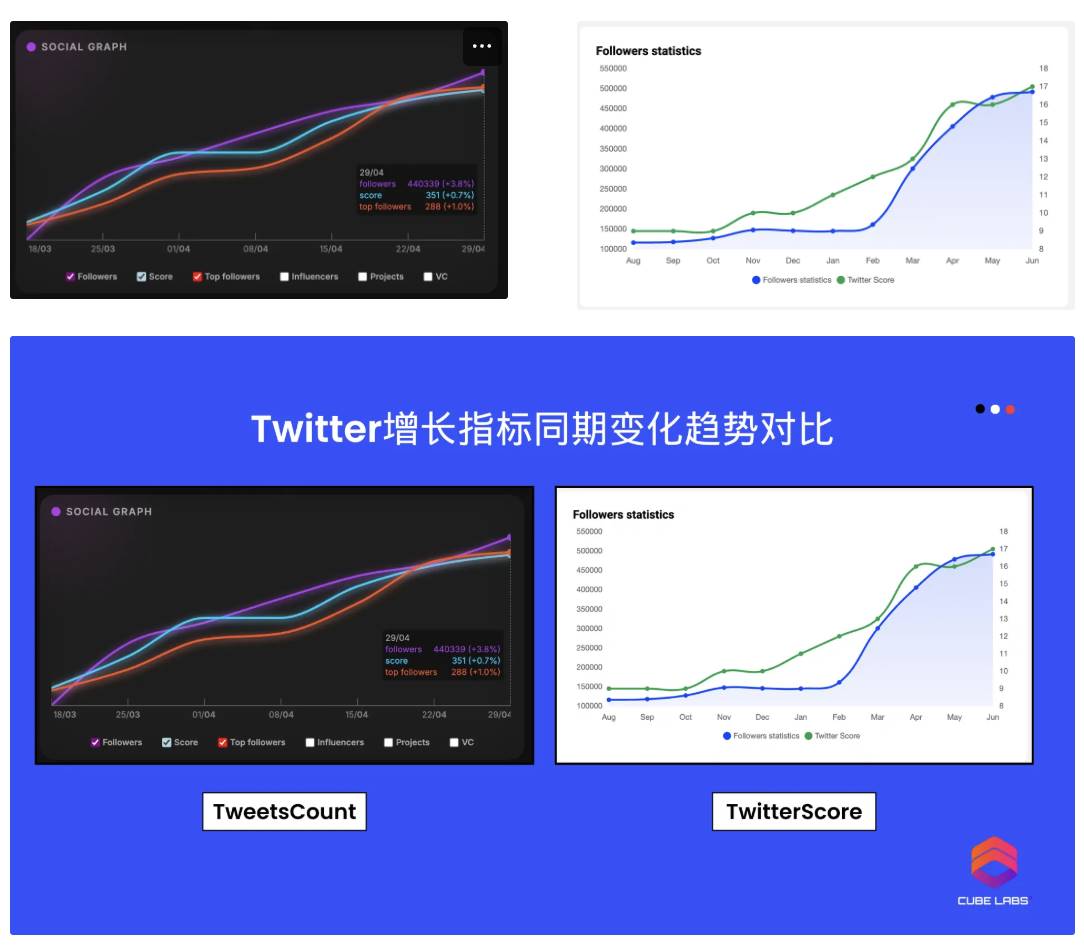
Kaito
Kaito's scoring model introduces the concept of "Smart Engagement," which not only considers what you tweet but also who interacts with you. If you can get high-quality users in the industry (such as project founders and investors) to retweet or like your posts, your score will naturally be higher. For Web3 projects, this means that the "network value" of an account is being quantified.
RootData
If you want to know whether a project founder is an "active evangelist," RootData provides the answer. It combines a Web3 investment and financing database to offer account influence scores and financing data for project teams, investment institutions, or VC leaders, suitable for track research and founder influence comparisons.
Below is a systematic overview of the evaluation focus and applicable scenarios of each platform:
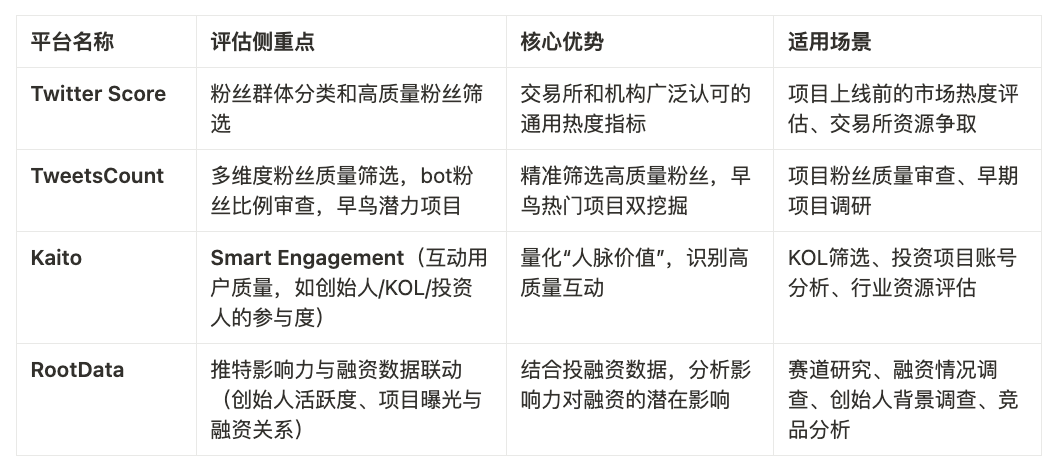
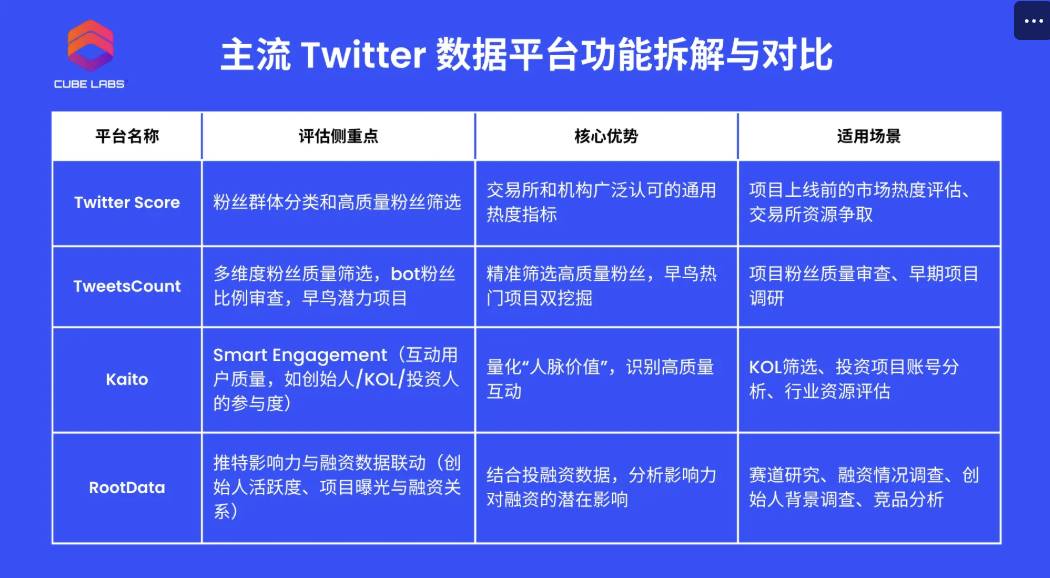
Key Analysis of Three Influencing Factors: Deep Logic from the Exchange's Perspective
So, what factors can influence the changes in TwitterScore?
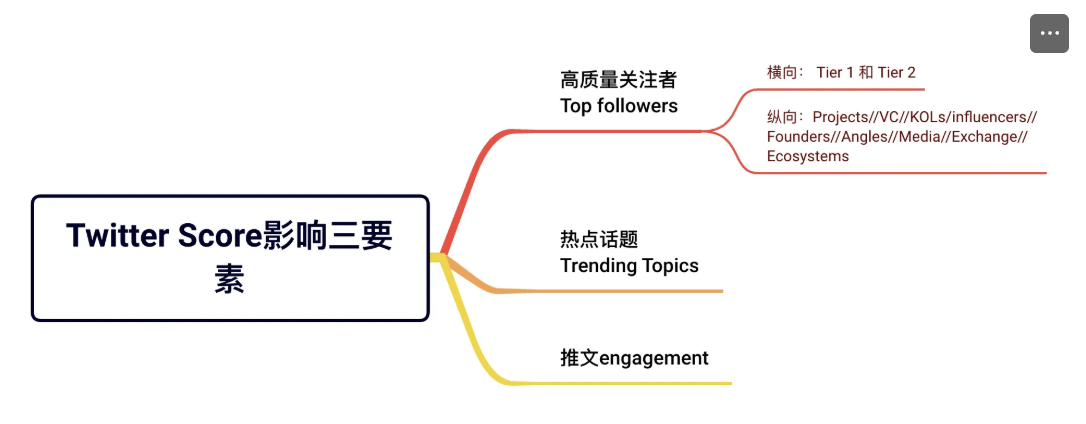
At the same time, we communicated with the official TwitterScore team, and the ultimate logic for score increases is:
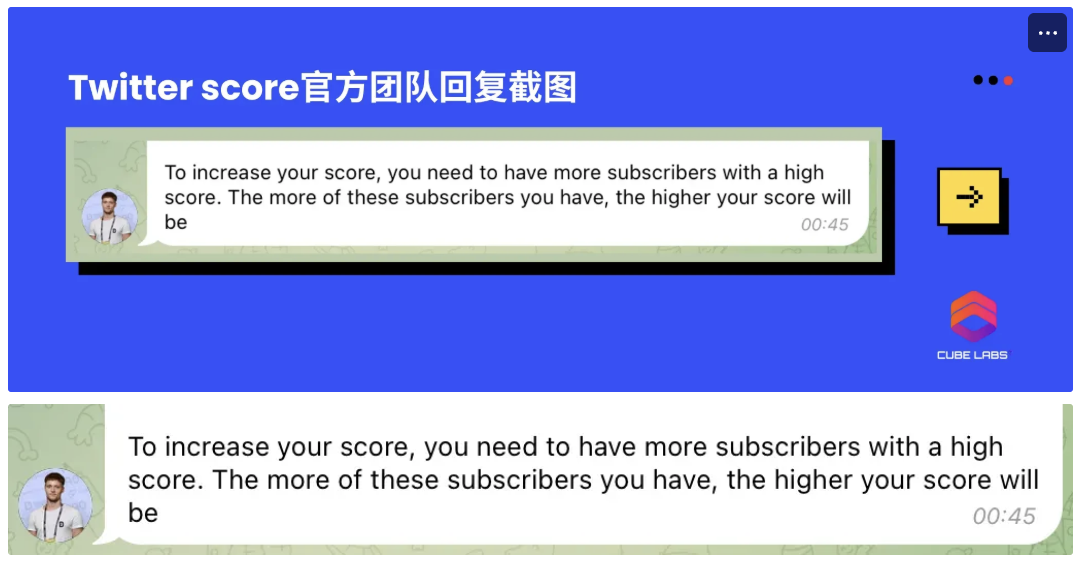
In summary, the higher the quality of your followers, the higher your score!
However, a careful breakdown of the three influencing factors of TwitterScore reveals significant insights; from another perspective, these dimensions are also the key evaluation criteria for the listing teams regarding projects, but they look much deeper than you might imagine:
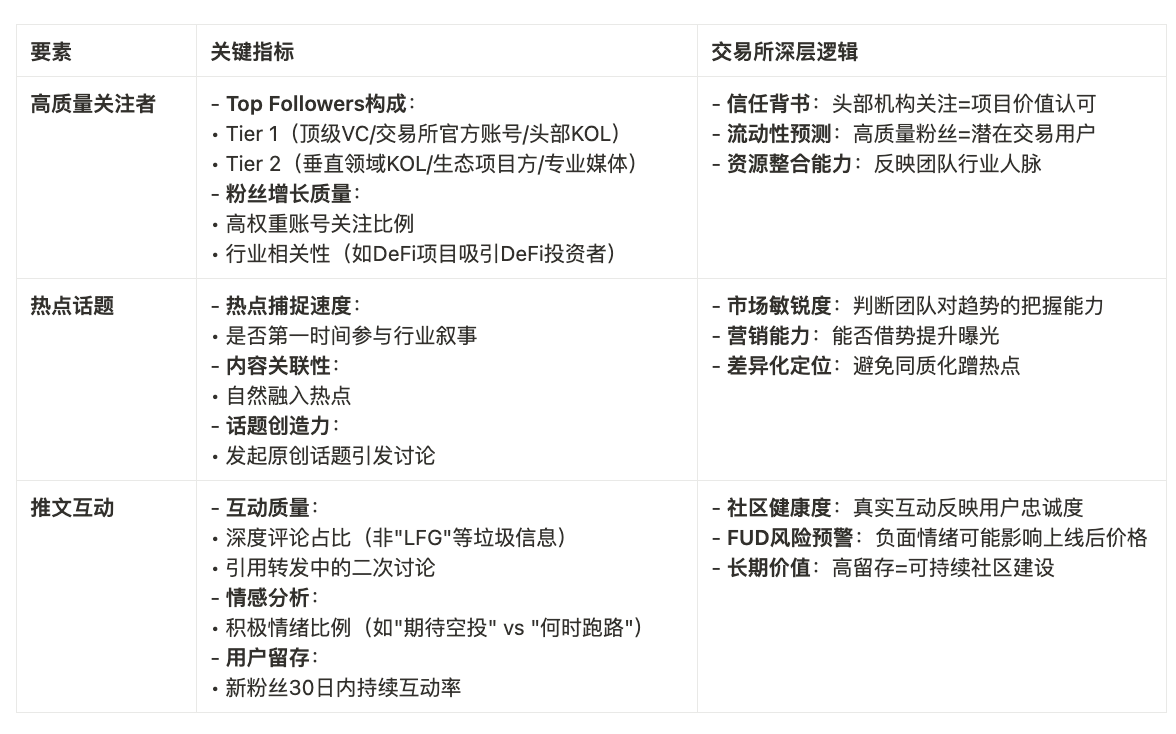
Quality of Followers (Top Followers):
* The attention from Tier 1/Tier 2 KOLs, VCs, founders, leading media, other ecosystem projects, especially official accounts of other exchanges, serves as a strong endorsement of trust.
- How do exchanges view this? They will scan your follower list. If the list is filled with numerous empty accounts, bots, or low-impact accounts unrelated to the project field, it will severely detract from your score. They are looking for real, relevant audiences with decision-making influence or strong dissemination power. These individuals are potential core users, evangelists, and liquidity providers for the project after it goes live. Their attention means your project has received preliminary recognition from "smart money" and key opinion leaders in the industry.
Trending Topics:
Effectively participating in or even leading trending topics demonstrates that the project is in tune with industry trends, possesses topical relevance, and market sensitivity. This directly relates to whether the project can capture market sentiment and gain trading volume and attention after launch.
How do exchanges view this? Exchanges place more importance on whether the project can naturally and insightfully integrate into mainstream narratives (such as Layer2, RWA, DePIN, Meme culture, etc.), rather than awkwardly riding the coattails of trends. This reflects the project's comprehensive capabilities in market positioning, community operation, and content creation. The ability of the project to create its own trends (such as successful event planning and major partnership announcements) further reflects its proactivity and market influence.
Tweet Engagement:
Engagement (views, likes, comments, retweets) is a direct reflection of community activity, stickiness, and genuine interest. A high engagement rate (relative to follower count) is more persuasive than absolute follower numbers.
How do exchanges view this? They delve deeply into the "quality" of engagement:
High-quality engagement = a healthy, loyal, and potential user base, which is the community asset that exchanges value most, directly relating to trading activity after launch.
Authenticity: Are comments like "Nice Project," "LFG," or are they in-depth discussions, questions, and constructive feedback? Are retweets from real users or obviously from bots?
Depth and Breadth: Is engagement concentrated among a few big influencers, or does it cover a wide range of community members? Does engagement spark deeper discussions (citing discussions in retweets)?
Sentiment: Is the community sentiment positive and expectant, or filled with doubts and FUD?
Retention: Do newly attracted followers (especially high-quality followers) continue to engage?
Growth Strategy "How to Do It": Multiple Strategies Based on Practical Experience
The strategy to enhance TwitterScore is essentially a strategy for building a "high-quality project community" in the eyes of exchanges. Based on a recent DePin case we worked on, we will detail our strategic approach as a marketing agency to break through each of the three dimensions. This is not only a strategy based on TwitterScore growth but also a methodology that project teams can refer to for increasing market attention and acquiring higher-quality users:

1. Systematically Attract and Consolidate High-Quality Followers
Broadly target similar benchmark projects
- In practical operations, we collected follower data from leading projects in the DePin track based on the specific categories provided by TwitterScore, listing all relevant Tier 1 & Tier 2: VC institutions and their partners, KOLs/Influencers, well-known project founders, influential media personnel/media accounts, key projects in the target ecosystem, and official accounts and core members of target exchanges.

- * We will focus on filtering high-scoring Tier 1 followers and have marked their corresponding ecosystems and scores (this feature has required a fee to view since May). Below is a reference display of some of the information we organized at that time:

Output Professional Content to Attract Attention
- Continuously produce high-quality, original, and insightful content (technical analysis, industry trends, in-depth thinking), regularly publishing milestones, technical updates, and clear roadmaps is fundamental to attracting institutional followers and serves as hard currency for attracting smart followers. During this period, we will conduct in-depth content breakdowns of existing research reports and technical progress for the project, then output them in the form of video clips or threads.
Proactively Establish Genuine Connections
- Before actively reaching out to these target individuals, it is essential to have a clear understanding and positioning of your own value: what can you bring to the other party? Is it exclusive information resources? In-depth collaboration opportunities? Valuable industry insights? Or content-level collaboration (such as inviting participation in AMAs, Twitter Spaces, etc.)? When making initial contact, it is best to approach from these angles and clearly and accurately convey these value points.
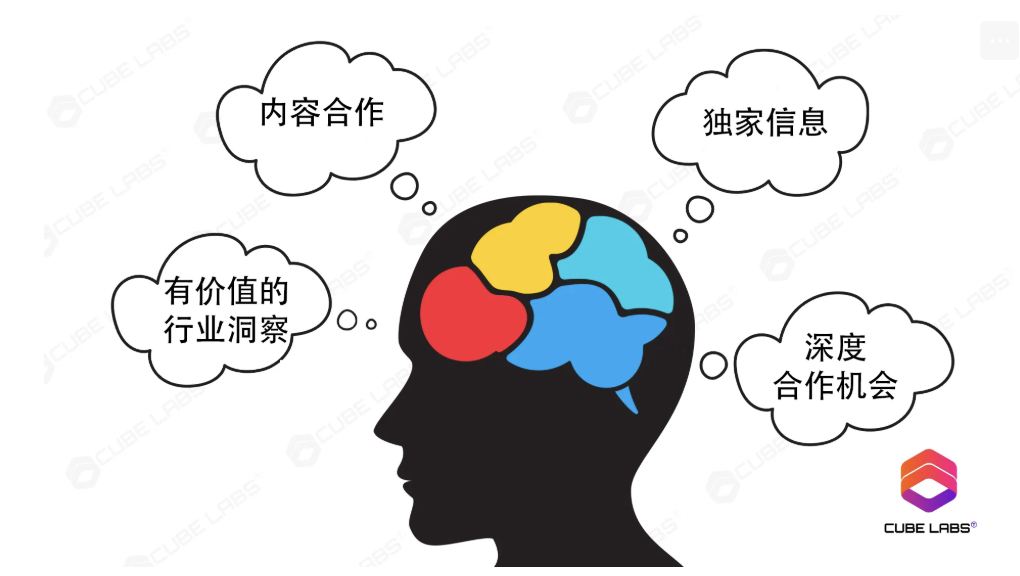
* The ways to reach out typically include:
* Twitter Comments: Make insightful and valuable comments (not spam) on the target's tweets to attract attention. * Direct DM: Clearly convey the value you can provide in the DM, preferably using an official account or a founder account with a certain number of followers. * Participate in Communities: Join the Discord/Telegram of target KOLs or projects, actively participate in discussions, and establish a presence.
2. Hot Topic Monitoring and Proactive Topic Creation
In the information-explosive Web3 world, capturing hot topics is key to breaking through and enhancing project visibility. Hot topics inherently attract attention and are the best way to break through and enhance visibility. What project teams need to do is:
Respond quickly to hot topics, cleverly linking them to the project's core values.
Design a clear conversion path to direct traffic to private channels, turning "hotness" into "stickiness."
Maintain eye-catching nodes within a long-term rhythm to ensure continuous exposure and deepening impressions.
In the memecoin field, this "traffic harvesting technique" is particularly common: projects capture short-term hot topics and quickly draw attention with "speed + fun + high volatility," maximizing the essence of attention economics. However, in the long run, deep construction and frequent memorable appearances must be balanced, as this is true business resilience.
Practical Case: Leveraging the "Blue Check Mutual Follow" Trend for Efficient User Acquisition
In April of this year, in response to news that Twitter would place more emphasis on the quality of blue check users' followers, a group of users began showcasing their "blue check follower ratios" on Twitter, and the #蓝标互关 (Blue Check Mutual Follow) tag quickly went viral, sparking a wave of mutual follows among Twitter blue checks.
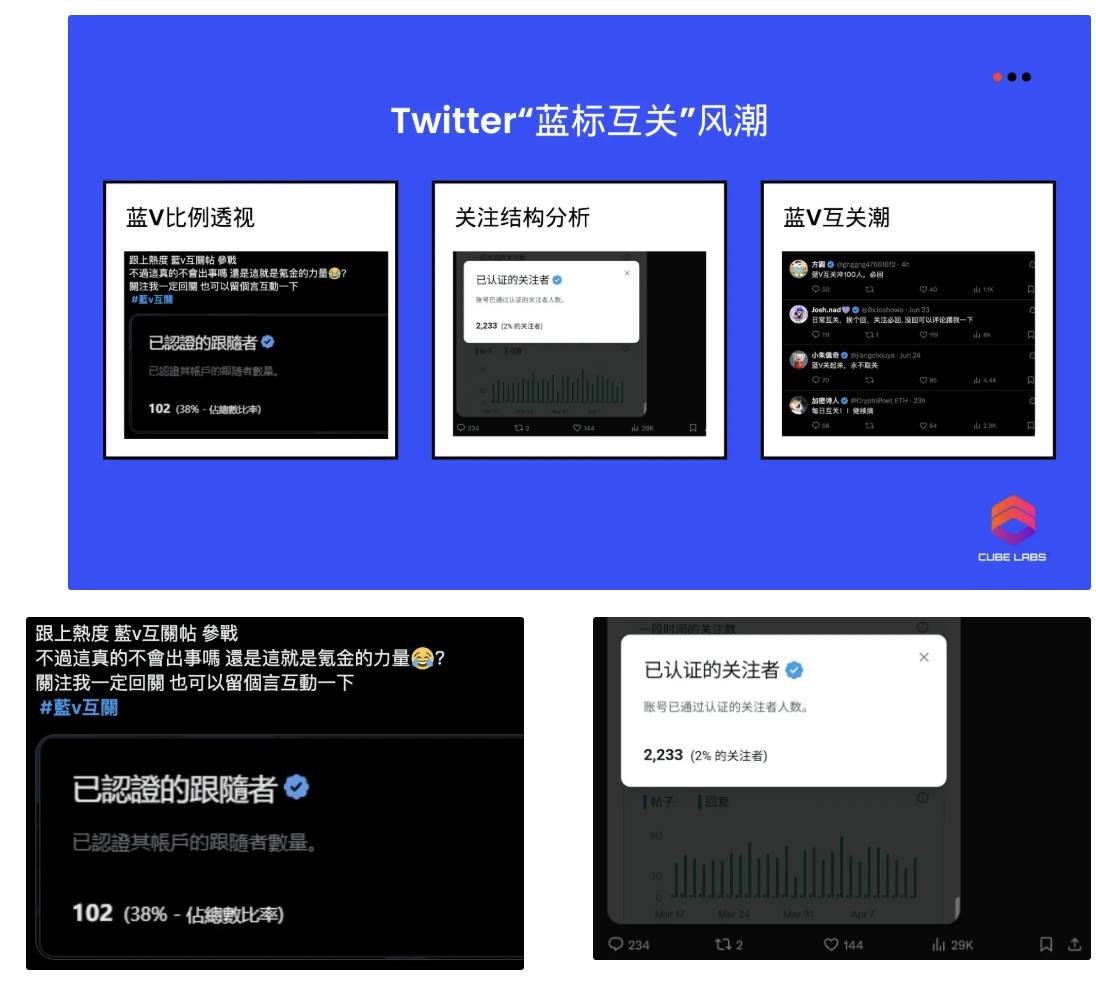
This mutual follow trend somewhat broke certain information bubbles, allowing many KOLs and blue check users to gain a significant amount of effective attention and tweet interactions in a short period, and it boosted the weight scores of evaluation platforms like Kaito. Such tweets continue to receive a large number of views and interactions today, becoming a preferred way for many blue check users to grow their accounts.
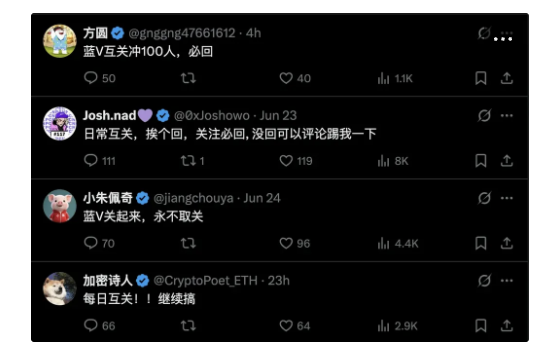
Returning to the practical case, how to leverage Twitter's natural traffic and social attributes to ride the wave of blue check mutual follows, we quickly designed a dedicated "Blue Check User VIP Program" for the project, with the specific conversion path as follows:
Blue check users follow the project on Twitter ➡️ join the project's Discord ➡️ automatically receive a special project identity badge (Role) and exclusive rights ➡️ layered operation and long-term maintenance.
This activity attracted over 500 blue check users to participate within just a few days, successfully achieving the dual value of "riding the traffic wave + bringing quality users into private channels." The core logic of this design lies in:
Utilizing Twitter hot topics: leveraging the natural traffic from #蓝标互关;
Efficiently directing traffic to private channels: Discord members quickly develop a willingness to be active;
Quality user retention and activation: forming a core community group, enhancing user stickiness and project value recognition.
3. Stimulating and Enhancing the Quality and Depth of Tweet Interactions
High-quality interactions are also an important dimension for measuring project vitality and community loyalty, not just likes and retweets, but also a reflection of deep exchanges, genuine resonance, and value co-creation among community members. To enhance interactions, the core lies in good content, genuine communication, and strong data support, with the goal of creating an active, insightful, and self-propagating community.
In our design for enhancing project engagement, we mainly adopted the following strategies:
Deploy Twitter Raiders: Organize small groups of real users to actively shill with viewpoints, enthusiasm, and reasoning in project tweets and discussions among KOLs and retail investors, igniting discussions and creating genuine hype.
Activate Community Chatters: Pre-arrange chatters in Discord/Telegram communities to quickly direct traffic, lead in-depth comments, and guide new users to participate during Twitter events/tweet releases, seamlessly connecting public and private domain heat.
Make Good Use of Video Materials: Use 15-30 second short videos to visually showcase product advantages and recent developments, replacing lengthy text. In our practical operations, we focused on breaking down the project's Messari research report and presenting it through a 1-minute engaging video, which greatly helped followers' readability and understanding.
Below are the engagement growth results we achieved for a project within two months:

Conclusion
In actual operations, we have observed that the current Twitter Score rating system, while having certain reference value, also has significant lag and error. For example, the follower structure and interaction activity of some accounts have clearly changed, but the scores have not been updated in a timely manner; in some cases, manual synchronization or waiting for the platform to refresh is required to reflect the latest social performance.
This means that using Twitter Score as the sole measurement indicator carries certain risks. Its scoring mechanism is not entirely transparent, and some dimensions (such as follower quality and interaction frequency) have ambiguous algorithmic weighting, which can easily lead to results deviating from actual social performance. Especially during phases of frequent project marketing actions and high user mobility, delays or distortions in scoring can more easily affect external observers' judgments, leading to "score anxiety" or operational misjudgments.
In fact, the score is just a tool and should not become the goal itself. What truly holds value is the real community activity represented behind the score, the continuous influx of quality users, the natural diffusion of topics, and the accumulation of emotional recognition. When users are still willing to interact and retweet without incentives, and content generates secondary dissemination within vertical circles, it signifies that the project has truly "established itself" on the social level. What exchanges or project teams should genuinely care about are the deep indicators hidden behind the components of TwitterScore:
Community Quality: Are core users precise, loyal, and influential? ➡️ Look at the composition of Top Followers & interaction depth.
Market Sensitivity and Influence: Can the project capture and shape market narratives? ➡️ Look at the effectiveness of hot topic participation/creation.
Community Health and Activity: Is the community real, enthusiastic, and constructive? ➡️ Look at interaction quality and emotional sentiment.
Project Professionalism and Trustworthiness: Does it demonstrate execution capability, transparency, and long-term value? ➡️ Consider all factors comprehensively, especially content quality and connections with high-quality entities.
Therefore, project teams should view TwitterScore as a valuable diagnostic tool and a guide for direction, rather than an ultimate goal. In the crypto world, quality will always penetrate noise more effectively and earn trust. Investing resources in building genuine industry relationships, creating valuable content, and cultivating an active and high-quality community is the fundamental way to enhance TwitterScore and the solid foundation for impressing exchanges and winning valuable "listing tickets."
免责声明:本文章仅代表作者个人观点,不代表本平台的立场和观点。本文章仅供信息分享,不构成对任何人的任何投资建议。用户与作者之间的任何争议,与本平台无关。如网页中刊载的文章或图片涉及侵权,请提供相关的权利证明和身份证明发送邮件到support@aicoin.com,本平台相关工作人员将会进行核查。




